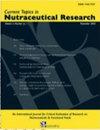Ligustilide Attenuates Intracerebral Hemorrhage-Induced Cardiac Damage via Nuclear Factor-Kappa B and Nuclear-Factor Erythroid 2-Related Factor 2 Pathways
IF 0.4
4区 医学
Q4 NUTRITION & DIETETICS
引用次数: 0
Abstract
Ligustilide is a bioactive component of the traditional Chinese herb Angelica sinensis that exhibits analgesic, anti-inflammatory, anticancer, neuroprotection, and anti-atherosclerosis pharmacological activities. Herein, the role of ligustilide in intracerebral hemorrhage-induced cardiac damage has been assessed. An autologous blood injection was used to induce intracerebral hemorrhage in CD-1 mice that resulted in an increase in systolic and diastolic blood pressure. Intraperitoneal administration of ligustilide reduced systolic and diastolic blood pressure, decreased plasma levels of adrenaline and noradrenaline in mice with intracerebral hemorrhage. Also, cardiac injury was observed in mice with intracerebral hemorrhage, as demonstrated by the upregulation of creatine kinase-MB, lactic dehydrogenase, and aspartate transaminase. Moreover, Picrosirius red staining showed cardiac fibrosis in intracerebral hemorrhage mice that was attenuated by ligustilide. Lastly, ligustilide reduced levels of interleukin-1β, tumor necrosis factor-α, interleukin-6, and reactive oxygen species in mice with intracerebral hemorrhage. Cardiac apoptosis in mice with intracerebral hemorrhage was also inhibited by ligustilide, as shown by reduced protein expression of phospho-p65, enhanced nuclear factor erythroid 2-related factor 2, and heme oxygenase-1 expression.藁本内酯通过核因子- κ B和核因子-红细胞2相关因子2通路减轻脑出血引起的心脏损伤
藁本内酯是中药当归中的一种生物活性成分,具有镇痛、抗炎、抗癌、神经保护和抗动脉粥样硬化等药理作用。本研究评估了藁本内酯在脑出血引起的心脏损伤中的作用。采用自体血液注射诱导CD-1小鼠脑出血,导致收缩压和舒张压升高。腹腔注射藁本内酯可降低脑出血小鼠的收缩压和舒张压,降低血浆中肾上腺素和去甲肾上腺素的水平。此外,脑出血小鼠的心脏损伤表现为肌酸激酶- mb、乳酸脱氢酶和天冬氨酸转氨酶的上调。此外,小天狼星红染色显示脑出血小鼠的心脏纤维化被藁本内酯减轻。最后,藁本内酯降低脑出血小鼠白细胞介素-1β、肿瘤坏死因子-α、白细胞介素-6和活性氧的水平。脑出血小鼠心肌细胞凋亡也受到藁本内酯的抑制,表现为磷酸化p65蛋白表达降低,核因子红系2相关因子2表达增强,血红素加氧酶-1表达增强。
本文章由计算机程序翻译,如有差异,请以英文原文为准。
求助全文
约1分钟内获得全文
求助全文
来源期刊
CiteScore
1.10
自引率
0.00%
发文量
36
审稿时长
>12 weeks
期刊介绍:
Current Topics in Nutraceutical Research is an international, interdisciplinary broad-based peer reviewed scientific journal for critical evaluation of research on chemistry, biology and therapeutic applications of nutraceuticals and functional foods. The major goal of this journal is to provide peer reviewed unbiased scientific data to the decision makers in the nutraceutical and food industry to help make informed choices about development of new products.
To this end, the journal will publish two types of review articles. First, a review of preclinical research data coming largely from animal, cell culture and other experimental models. Such data will provide basis for future product development and/or human research initiatives. Second, a critical evaluation of current human experimental data to help market and deliver the product for medically proven use. This journal will also serve as a forum for nutritionists, internists, neurologists, psychiatrists, and all those interested in preventive medicine.
The common denominator of all of the topic to be covered by the journal must include nutraceuticals and/functional food. The following is an example of some specific areas that may be of interest to the journal. i) Role of vitamins, minerals, antioxidants and phytonutrients on cardiovascular health, cancer, diabetes, ocular health, mental health, men’s health, women’s health, infant nutrition, ii) Role of herbals on human health, iii) Dietary supplements and sleep, iv) Components of diet that may have beneficial effect on human health, v) regulation of apoptosis and cell viability, vi) Isolation and characterization of bioactive components from functional foods, vii) Nutritional genomics, and viii) Nutritional proteomics.

 求助内容:
求助内容: 应助结果提醒方式:
应助结果提醒方式:


